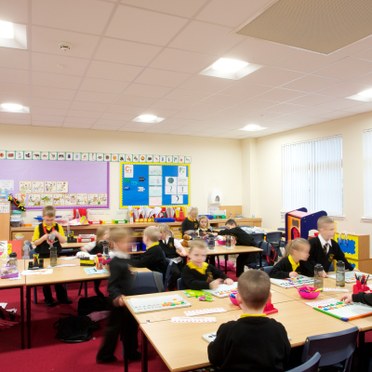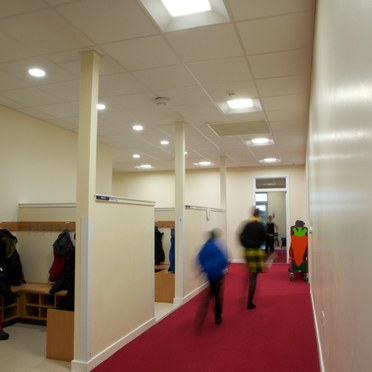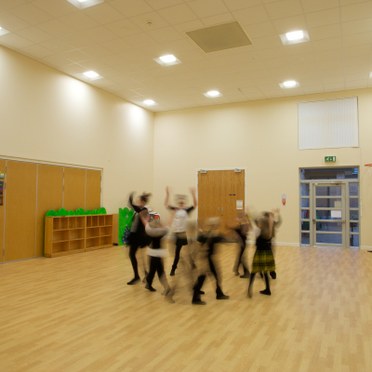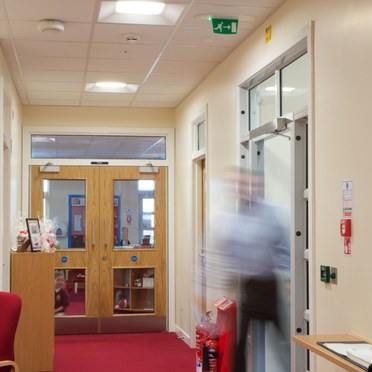Netherburn Primary School, UK
- Lamp efficacy
Lamp efficacy
Ensuring the lamp efficiently converts electricity into light (lm/W).
- Ballast classification
Ballast classification
Controlling the electricity supply to the lamp (Energy Efficiency Index).
- Luminaire distribution
Luminaire distribution
Controlling light emission using optics which bend and shape the light to the correct location.
- System efficacy
System efficacy
Combining optical and thermal control within the luminaire (luminaire lm/W).
- Presence/absence detection
Presence/absence detection
Presence: Lights automatically turn on/off with movement. Absence: Lights automatically turn off and must be manually switched on.
- Daylight detection
Daylight detection
Artificial lighting which responds to the natural light conditions.
- Constant illuminance
Constant illuminance
A function designed to produce correct light levels for the duration of the maintenance period.
- Task-scene setting
Task-scene setting
Allowing the user to set scenes and adapt the lighting to different tasks.
- Timed off
Timed off
Automatic cut-off can be installed to turn all lights off during unoccupied hours.
- Task lighting
Task lighting
Lighting task areas with the correct amount of light.
- Zoning of lighting
Zoning of lighting
Lighting is zoned according to area use.
- Maintenance schedule
Maintenance schedule
Maintenance must be performed in response to product age, performance and environment.
- Waste light
Waste light
Eliminating waste light which does not hit the intended target.
- Reflectance
Reflectance
Taking advantage of light which is reflected from the surface within the space.
- Visible smart metering
Visible smart metering
Results of actions can be quickly seen as increased or decreased energy use to encourage responsible energy consumption.
Quattro LED passes its first examination
New premises built for Netherburn Primary School in Larkhall, Scotland were designed by South Lanarkshire Council to replace the original older building. The new facility will help transform the learning experiences of children, both now and in the years to come. Not unnaturally, the Council required first class lighting - high quality control of the light distribution to ensure good teaching conditions, together with an attractive appearance and economical operation through life.
A major feature of the £2.4m building is the use of LED equipment throughout, including four general classrooms, a sports hall, kitchen, circulation areas, toilets, office facilities and nursery.
Among the luminaires used are 108nr. recessed modular 48W Quattro LEDs and 50nr. Base LED downlights. The lighting in the classes are controlled by our Sensa Modular system.
It was not simply the aesthetic appeal of the luminaires which prompted the choice. The advent of LEDs had given the opportunity of formulating a new lighting package which not only gave high quality colour rendering (Ra 92), but also significantly reduce energy usage.
Some idea of the improvement in performance can be seen by the fact that to achieve an illuminance approaching 400 lux in one of the larger classrooms with conventional fittings (MenloSoft) using 2x40W TC-L lamps would require 11 fittings, giving 398 lux for an installed load of 14.10 W/m². The same number of Quattro LED luminaires achieves 380 lux for a load of only 7.69 W/m². Running costs are cut by 45%, and the long LED lifetime is expected to generate considerable savings in maintenance.
LEDs do more than provide general lighting; they also help supply emergency lighting. Compact, recessed Voyager LED Series luminaires (Area & Route models) and Voyager Sigma LED exit signs switch on automatically in the event of a power failure.
Netherburn Primary School is worth watching: with the Council rebuilding or refurbishing every primary school it could become a catalyst for transforming lighting performance.




